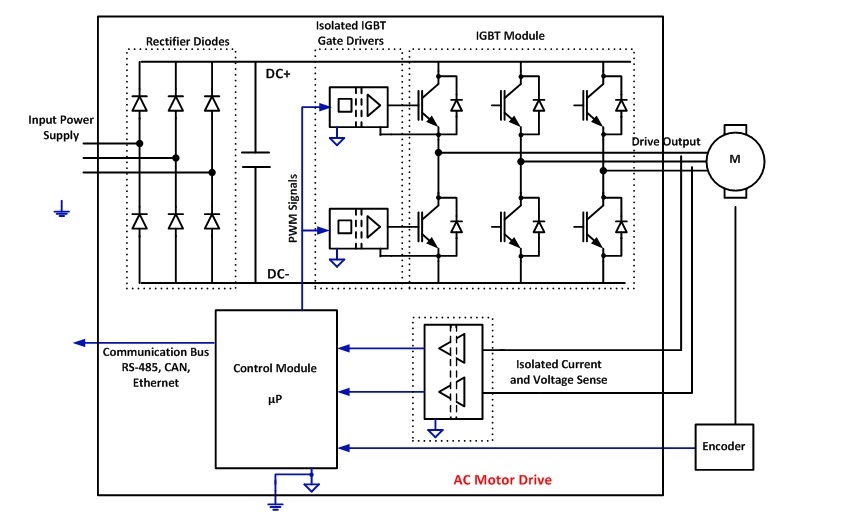SSZTCA4 August 2015 ISO5451 , ISO5851
Effective isolation is a way to minimize DC and uncontrolled transient currents from flowing between two circuits while allowing information and power transfer to occur. Integrated circuits (ICs) that enable isolation are called isolators.
Some applications use isolation for functional purposes; that is, to get systems to work properly. Two examples of functional isolation are preventing ground potential differences (GPDs) between two 24-V systems physically placed apart on a factory floor, and communication between 12-V and 48-V domains in a car. Many other applications use isolation techniques to help create an insulating link between a first circuit connected to potentially hazardous voltage and a secondary, low-voltage circuit that may be accessible to a human operator when the isolation level is appropriately defined and implemented. Examples of such systems include medical equipment, test and measurement equipment, power tools, power supplies, electric vehicle chargers, and industrial motor drive systems.

In the simplified block diagram of an industrial AC motor drive shown in Figure 1, the incoming grid power supply, rectified DC+ and DC– buses, insulated gate bipolar transistor (IGBT) terminals, and three-phase output of the AC drive all carry high voltages. The module that controls the motor drive is comprised of low-voltage circuitry, and may have interfaces and connectors accessible to human operators. In this case, the isolated IGBT gate drivers and isolated voltage and current-sense circuits act as insulation barriers, and help prevent high voltages from appearing on connectors and interfaces that may be accessible to human operators. This is in addition to the normal functional role that the isolators perform: providing control voltages to the IGBT, and voltage and current feedback to the control module for operational purposes not related to electrical safety.
 Figure 1 Simplified Block Diagram of an
industrial AC motor drive
Figure 1 Simplified Block Diagram of an
industrial AC motor driveDepending on the application, where risk to human safety is involved, end-product safety standards (such as, IEC 61800-5-1[i] and IEC 61010-1[ii]) require that there be at least two basic levels of insulation or two basic isolators (also referred to as double insulation) between high-voltage and exposed parts so that even if one isolator fails to insulate as designed, the other can offer safety protection at the same level. Another option is to use a single isolating approach employing reinforced insulation, which provides similar protection as two basic insulating systems in series. Reinforced insulation must meet stricter requirements compared to basic isolation, since damage to the reinforced insulation system can result in potential risks.
Isolators used to enhance electrical safety need to withstand voltage stresses of different magnitudes and duration, depending on the particular application. The first, of course, is the continuous voltage present across the isolator’s insulation barrier, sustained during normal operation and throughout the anticipated lifetime of the end product application. This is called working voltage. Next is temporary overvoltage (lasting 5 s to 60 s) caused by load changes or short circuits in the incoming voltage supply system Additional high voltage conditions include surge or impulse voltages, which represent overvoltage often caused by direct or indirect interference sources, such as lightning strikes, faults, etc. These stresses represent real-life interference scenarios where the insulating properties of isolation components must not break down, since such breakdown could compromise the electrical safety of the equipment. Besides tolerating such voltage conditions, the isolator packages must have a certain minimum spacing between the high-voltage and low-voltage pins, measured along the shortest distance of the isolator (creepage) to minimize package degradation including short circuit due to introduction of moisture and/or other environmental contaminants, and through the air spacings (clearance) to minimize risk of arcing.
The requirements on the amplitudes and duration of these externally influenced stresses are dictated by the corresponding end-equipment standard, and are commensurate with the supply or other high voltages being sourced. For example, the IEC 61800-5-1 establishes electrical safety requirements for industrial AC motor drives.
TI recently released the ISO5851 and the ISO5451 reinforced isolated gate drivers. These devices enable design of reinforced and basic isolation per IEC 61800-5-1.
What else would you like to know about isolation? Leave a comment below and stay tuned to the Industrial Strength blog in the coming months to read more on this topic.
Additional Resources
- Read the datasheets for TI’s ISO5851 and ISO5451 gate drivers.
- Kick-start your next design with TI’s Digital Isolator Design Guide.
- Read TI’s white paper, “High-voltage reinforced isolation: Definitions and test methodologies.”
- Learn more about isolation with TI’s Isolation Glossary.
[All information is provided by TI subject to TI Terms of Use]
#Dummy#
[i] IEC 61800-5-1 Ed. 2.0. Adjustable speed electrical power drive systems, safety requirements, electrical, thermal and energy. July 2007.
[ii] IEC 61010-1 Ed 3.0, Safety requirements for electrical equipment for measurement, control, and laboratory use, general requirements, June 2010.